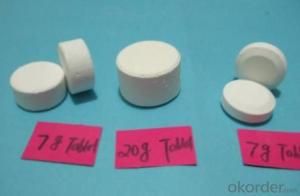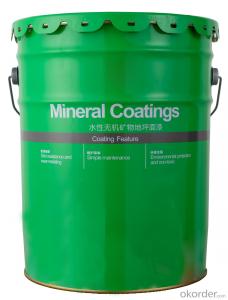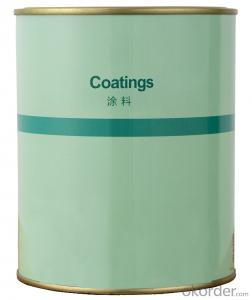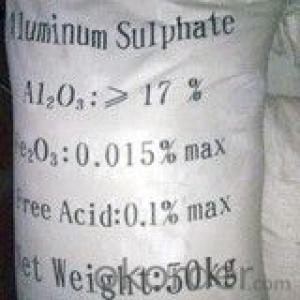Pool Disinfectant SDIC Powder Granular Tablets
- Loading Port:
- Tianjin
- Payment Terms:
- TT OR LC
- Min Order Qty:
- 17 m.t.
- Supply Capability:
- 1800 m.t./month
OKorder Service Pledge
OKorder Financial Service
You Might Also Like
SDIC
The Structure Of SDIC Introduction:
CNBM--SDIC White powder or grain with chlorine odor . It is a strong oxidant and chlorate agent and can dissolved in water easily . Its aqueous solution assumes weak acidity and the active chlorine in its dry products lose little when it is stored for a long time at the atmospheric temperature .
Quick dissolving tablet within 10 minutes. It is used in hospital, hygienic, disaster protection, food industry, and aquaculture etc.
The tablet have 0.5g, 1.0g, 3.3g, 5g, 7g, 10g.
Packed in 100g, 500g, 1kg, 2kg, 3kg & 5kg plastic bucket.
And we can supply tablet form: 1g, 2.7g, 3.3g, 3.5g, 5g, 10g & 20g.Package: in 500g, 1kg, 2kg, 5kg or do with customer requirements
Main Feautures of SDIC:
Good Quality, Powder, Granular, Tablets.
SDIC Image:

SDIC Specification:
Chemical Name | Sodium Dichloroisocyanurate | |
Molecular Formula: | C3O3N3HCL2NA | |
Molecular Weight: | 220.96 | |
CAS Number: | 2893-78-9 | |
Product | 60% | 56% |
Available chlorine(%,min) | 60 | 56 |
Moisture content(% max) | 5 | 8 |
PH Value(1% solution) | 6-7 | 6-7 |
Particles Size:
Mesh | 5~8 | 8~30 | 20~40 | 20~60 |
Application of SDIC in water treatment
1)It can be used for swimming pool and drinking water treatment, clean the industrial circulating water.
2)It can be used as preventive disinfection of house, hotel, hospital and public place; used on the environmental sterilization of raising fish.
3)It can be used to bleach the textile, to prevent wool from shrinkage, to prevent paper by decay and act as rubber chlorination.
Package:
50KG PLASTIC DRUMS/ FIBER DRUMS.
25KG PLASTIC DRUMS/FIBER DRUMS.
1000KG BIG BAGS.
Or any other packages suggest by customers.
- Q:Effect of Catalyst on Chemical Reaction Rate
- The catalyst can reduce the activation energy of the chemical reaction and allow the reaction to take a shortcut
- Q:what is metallocene catalyst technology?
- Metallocene catalyst A transition-metal atom sandwiched between ring structures having a well-defined single catalytic site and well-understood molecular structure used to produce uniform polyolefins with unique structures and physical properties. See also Catalysis; Coordination chemistry; Coordination complexes; Metallocenes; Organometallic compound. In the early 1980s, W. Kaminsky discovered that an appropriate co-catalyst activated metallocene compounds of group 4 metals, that is, titanium, zirconium, and hafnium, for alpha-olefin polymerization, attracting industrial interest. This observation led to the synthesis of a great number of metallocene compounds for the production of polymers already made industrially, such as polyethylene and polypropylene, and new materials. Polymers produced with metallocene catalysts represent a small fraction of the entire polyolefin market, but experts agree that such a fraction will increase rapidly in the future. See also Polymer; Polymerization; Polyolefin resins.
- Q:I think doubling the concentration of catalyst will double the rate of a reaction (K2/K1 =2). I want to confirm. This is for my project work. Please reply as soon as possible.
- A catalyst speeds up a chemical reaction by providing an alternate reaction pathway with a lower activation energy, thus increasing the number of collisions that can result in the formation of product. When the catalyst is a reactant in the rate determining step, and the reaction is first order in the catalyst, then a doubling of the concentration will double the rate. But if the rate determining step which includes the catalyst is not first order, then doubling the concentration won't double the rate. Then there is the case of a heterogeneous catalyst in which the reaction is essentially zero order in the catalyst. The amount of catalyst won't affect the speed of the reaction beyond the initial increase. The mere fact that the catalyst is present speeds up the reaction.
- Q:How does the catalyst generally add to the organic chemical reaction?
- In the case of heterogeneous catalysis, the specific surface of the catalyst, in addition to the activity of the catalyst, is an important factor in determining the reaction rate, which means that the specific surface for catalysis is large and the reaction is as fast as the whole. So the overall principle in understanding the activity of the premise of the catalyst, would like to quickly add a little more.
- Q:What is the difference between biological enzymes and chemical catalysts?
- Biological enzymes are an environmentally friendly biocatalyst with greater superiority. Such as the reaction speed, processing conditions (such as temperature, PH value, etc.) more moderate, safe and easy to control the operation and can replace the strong alkali and other chemicals. The biological enzymes act only on specific substrates, with little damage to the substrate and the biodegradation of the treated wastewater to reduce water and energy consumption. After more than a century of research by scientists, more than 3,000 known enzymes are generally considered. The application of biological enzymes in the textile industry, initially the application of α-amylase in cotton fabric desizing process, and later developed into the cellulase used in denim washing and bio-polishing process, and now the development of pectinase to the biological scouring Technology, hydrogen peroxide enzyme catalytic decomposition technology, protease in silk and wool fiber applications
- Q:Chemical catalyst in several ways
- In general, positive catalyst (accelerated rate) and negative catalyst (slowing down)
- Q:Nitrogen and hydrogen in the role of high temperature and pressure catalyst to generate ammonia chemical equation
- N2 + 3H2 = catalyst, high temperature and high pressure = 2NH3
- Q:Chemical reactions in the presence of impurities will cause catalyst poisoning, how to understand this sentence
- Catalyst in use will be due to various factors and loss of activity, one of the important factors is poisoning. There are several possible reasons for the poisoning of the catalyst. The small amount of impurities contained in the original branch, or the strong adsorption (mostly chemical adsorption), or the chemical center of the active center, So that active center poisoning. In addition, there may be such poisons in the reaction product; in the preparation of the catalyst, the impurities contained in the carrier interact with the active component and may also poison the active center.
- Q:How does catalyst aid a chemical reaction?
- it makes the reaction go faster.
1. Manufacturer Overview |
|
|---|---|
| Location | |
| Year Established | |
| Annual Output Value | |
| Main Markets | |
| Company Certifications | |
2. Manufacturer Certificates |
|
|---|---|
| a) Certification Name | |
| Range | |
| Reference | |
| Validity Period | |
3. Manufacturer Capability |
|
|---|---|
| a)Trade Capacity | |
| Nearest Port | |
| Export Percentage | |
| No.of Employees in Trade Department | |
| Language Spoken: | |
| b)Factory Information | |
| Factory Size: | |
| No. of Production Lines | |
| Contract Manufacturing | |
| Product Price Range | |
Send your message to us
Pool Disinfectant SDIC Powder Granular Tablets
- Loading Port:
- Tianjin
- Payment Terms:
- TT OR LC
- Min Order Qty:
- 17 m.t.
- Supply Capability:
- 1800 m.t./month
OKorder Service Pledge
OKorder Financial Service
Similar products
New products
Hot products
Related keywords


























